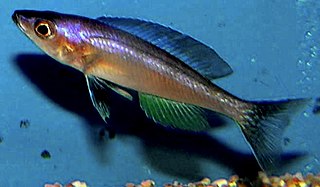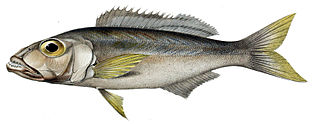
"Sardine" and "pilchard" are common names that refer to various small, oily forage fish in the herring family Clupeidae. The term "sardine" was first used in English during the early 15th century and may come from the Mediterranean island of Sardinia, around which sardines were once abundant.

George Albert Boulenger was a Belgian-British zoologist who described and gave scientific names to over 2,000 new animal species, chiefly fish, reptiles, and amphibians. Boulenger was also an active botanist during the last 30 years of his life, especially in the study of roses.

The ciscoes are salmonid fish of the genus Coregonus that differ from other members of the genus in having upper and lower jaws of approximately equal length and high gill raker counts. These species have been the focus of much study recently, as researchers have sought to determine the relationships among species that appear to have evolved very recently. The term cisco is also specifically used of the North American species Coregonus artedi, also known as lake herring.

Oreochromis is a large genus of oreochromine cichlids, fishes endemic to Africa and the Middle East. A few species from this genus have been introduced far outside their native range and are important in aquaculture. Many others have very small ranges; some are seriously threatened, and O. ismailiaensis and O. lidole possibly are extinct. Although Oreochromis primarily are freshwater fish of rivers, lakes and similar habitats, several species can also thrive in brackish waters and some even survive in hypersaline conditions with a salinity that far surpasses that of seawater. In addition to overfishing and habitat loss, some of the more localized species are threatened by the introduction of other, more widespread Oreochromis species into their ranges. This is because they—in addition to competing for the local resources—often are able to hybridize.

Cyprichromis is a genus of cichlids with five species. They are also known as the herring cichlids or sardine cichlids, since they form large schools in the open water of Lake Tanganyika. Of the known species, only C. microlepidotus has been recorded outside Lake Tanganyika.

Bathybates is a genus of piscivorous cichlids endemic to Lake Tanganyika in East Africa. The genus includes both pelagic species that mainly feed on Tanganyika sardines and benthic species that mainly feed on other cichlids. They are some of the deepest-living cichlids, regularly occurring down to 200 m (660 ft).
Mastacembelus is a genus of many species of spiny eel fish from the family Mastacembelidae. They are native to Africa and Asia. Most are found in rivers and associated systems, but there are also species in other freshwater habitats and a particularly rich radiation is found in the Lake Tanganyika basin with 15 species. A few species can even occur in brackish water.

Synodontis is the largest genus of mochokid catfishes. It is the biggest genus within the 10 genera and 190 different species in the family Mochokidae. Synodontis has over 131 different species within the genus. Synodontis are also known as squeakers, due to their ability to make stridulatory sounds through their pectoral fin spines when handled or disturbed. Synodontis make a sound that sounds like squeaking by rubbing their spines together. They do this when they have been frightened or when they become angry. Synodontis may also squeak when they are taken out of the water. These catfish are small- to medium-sized fish with many species exhibiting attractive spotted markings. Some species are also known for naturally swimming belly-up, earning the name upside-down catfish. Some of these species are Synodontis contractus and Synodontis nigriventris. While some of these species are known to swim upside down, another species, Synodontis multipunctatus, is a brood parasitic cuckoo catfish.

Rhamphochromis is a genus of East African haplochromine cichlids endemic to the Lake Malawi basin, also including Lake Malombe, Lake Chilingali, Chia Lagoon and upper Shire River. They mainly occur in offshore open waters, but a few species also near the coast. They are piscivores that typically feed on lake sardines and small utaka cichlids.
Chelaethiops minutus is a species of ray-finned fish in the family Cyprinidae. It is endemic to Lake Tanganyika and its outflow, the Lukuga River and is found in Burundi, Democratic Republic of the Congo, Tanzania, and Zambia.
The Lake Rukwa sardine is an African species of freshwater fish in the family Cyprinidae. It is found only in Tanzania. Its natural habitat is freshwater lakes. It is threatened by habitat loss.

The Lake Malawi sardine, lake sardine, or usipa, is an African species of freshwater fish in the family Cyprinidae. It is endemic to Lake Malawi and its outlet, the (upper) Shire River; it is found in Malawi, Mozambique, and Tanzania.
Engraulicypris is a genus of fish in the family Cyprinidae endemic to Africa. In a study of mitochondrial genealogy, the species formerly included in Mesobola are not phylogenetically separated from Engraulicypris and therefore should also be included in Engraulicypris.
The Malagarasi sardine is an East African species of freshwater fish in the family Cyprinidae. It is endemic to the Malagarasi River in Burundi and Tanzania. Its natural habitats are rivers, intermittent rivers, freshwater lakes, freshwater marshes, and inland deltas. It is threatened by habitat loss.

Raiamas is a genus of cyprinid freshwater fishes. The majority of the species are from Africa, but R. bola and R. guttatus are from South and Southeast Asia.
Bathybagrus is a genus of claroteid catfishes native to Africa where they are only found in Lake Tanganyika.

The Lake Tanganyika sardine is a species of freshwater fish in the family Clupeidae which was endemic to Lake Tanganyika but which has now been introduced to other lakes in Africa as a food source. It is monotypic within the genus Limnothrissa. It and the Lake Tanganyika sprat are known collectively as kapenta.

Labeobarbus is a mid-sized ray-finned fish genus in the family Cyprinidae. Its species are widely distributed throughout eastern Africa and especially southern Africa, but also in Lake Tana in Ethiopia. A common name, in particular for the southern species, is yellowfish. The scientific name refers to the fact that these large barbs remind of the fairly closely related "carps" in the genus Labeo in size and shape. As far as can be told, all Labeobarbus species are hexaploid.

Microthrissa royauxi, the royal sprat, is a species of pelagic, freshwater fish from the herring family Clupeidae which is found in the Congo River basin in west Africa. It was described in 1902 by the Belgian-British zoologist George Albert Boulenger. It is of limited importance as a food fish in subsistence fisheries and its conservation status is Least Concern.
Engraulicypris bredoi or Mesobola bredoi is an East African species of freshwater fish in the family Cyprinidae. It is endemic to Lake Albert in Uganda and the Democratic Republic of the Congo. Its natural habitats are rivers, intermittent rivers, freshwater lakes, freshwater marshes, and inland deltas. It is threatened by habitat loss.












